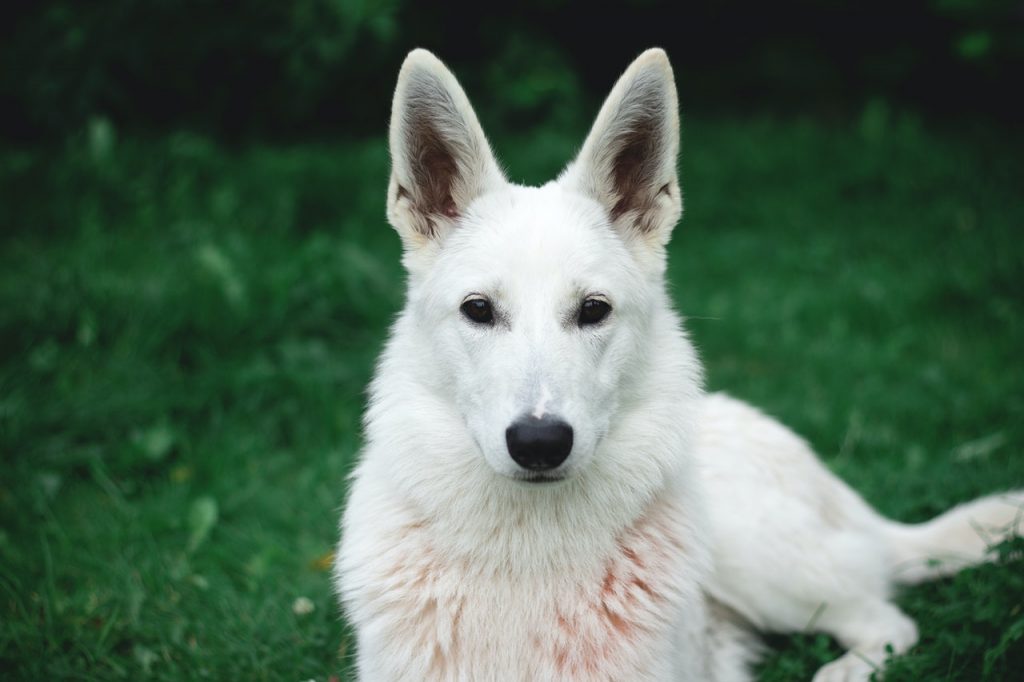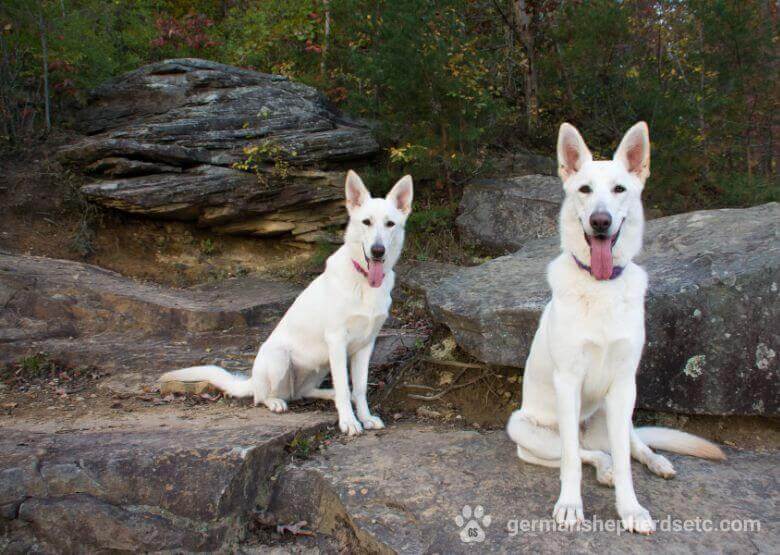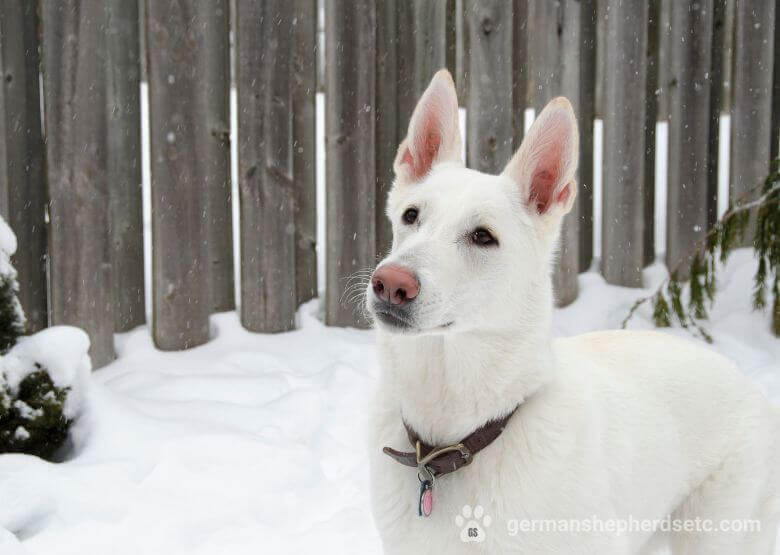Table of Contents
White German Shepherds have been in existence since the early foundations of the breed. The German Shepherd has its roots in Germany, where the countryside was populated by herding dogs that their farm families greatly cherished for their protective nature, ability to manage hundreds of sheep, and their companionship. White shepherds were common at that time, as well as the better recognized black and tan patterned dogs that are seen today.
The German Shepherd is an easily recognized breed that has captured the hearts and imaginations of dog lovers for over a hundred years. The black-and-tan coat, erect ears, athletic body structure, and innate intelligence make it a perfect animal for various work tasks. From the beginning of the German Shepherd line development, the recessive gene of an all-white coated dog was evident.
Today, enthusiasts of the White Shepherd breed descended from the original dogs are working to have this line recognized as a separate breed, with distinct characteristics that should be appreciated on their own merits.
The White German Shepherd Dog History
The first white German Shepherd to appear on the show circuit was a dog named Greif, who was shown at two shows in Hanover in 1882 and 1887. Years later, Max von Stephanitz, the father of the German Shepherd Dog as a recognized breed, saw and fell in love with a German Shepherd named Hektor Linksrhein. Von Stephanitz purchased him immediately. This dog, which von Stephanitz then gave the name Horand, became the first dog registered in Germany’s German Shepherd Dog Registry. This dog was also the grandson of Greif, carrying the white recessive gene. White German Shepherds appeared in subsequent litters, with Horand’s grandson Berno v.d.Seeweise registered as the first white Shepherd in the German national registry. Von Stephanitz, in his well-known book on German Shepherds, decisively concluded:
“The coloring of the dog has no significance whatsoever for service.”
Max von Stephanitz
In later years the Nazi party took over leadership of the German Shepherd registry, quickly moving to discourage all efforts to breed white German Shepherds. They believed there were two major problems that resulted from continuing to breed white German Shepherds. First, they thought that the white gene was responsible for causing genetic issues within the breed. Second, they also believed that the white gene was responsible for causing a general lack of dark pigmentation in the breed, thus ‘fading’ the coat colors of the tan and black shepherds. (Later work in the field of genetics has proven that the white recessive gene causing the white coat color masks the dog’s coat color; it does not cause fading or discoloration in subsequent litters.)
According to reports at that time, numerous German Shepherd puppies born with white coats were summarily slaughtered. From that point on, there are no “official” records of the existence of white German Shepherds in Germany. White puppies still show up in the breed in Germany today, as the genetic trait can be passed down by a dog with standard coloring. But since white dogs are not registered, there are no official records that they even exist.

White German Shepherds in the United States
This type of discriminatory thinking led to a move in 1968 by the German Shepherd Dog Club of America to pressure the American Kennel Club to disqualify all-white German Shepherds from participating in AKC conformation shows. The AKC agreed, disqualifying white German Shepherds from conformation events. Dogs could still be registered with the AKC and shown at events such as obedience, tracking, herding, etc. Avid white German Shepherd breeders formed an association to protect the white shepherds in the US, and the White German Shepherd Dog Club International, Inc. was born.
White German Shepherds in Canada
Following the American decision, in 1980, the German Shepherd Dog Club of Canada requested that the Canadian Kennel Club disqualify white dogs from conformation shows. However, the Canadian Kennel Club refused to do this, and for years, white German Shepherds were shown in conformation rings. In 1998, however, the Canadian Kennel Club finally banned white German Shepherds from conformation shows altogether.
In both America and Canada, the white-coated shepherds began highly valued, even as they were dismissed as being of a color that was unacceptable as part of the breed standard. Over time, breeders began to breed for the white coat, but they never used dogs other than German Shepherds since their arrival in North America.
These animals were often less aggressive than their traditionally colored counterparts, making them highly esteemed as a family companion dog. They continued to exhibit all the intelligence, trainability, and strength of the traditional breed standard. They have a slightly less angulated line from shoulder to hip and a gentler nature. They are significantly different from the standard GS breed.
In other areas of the world, they are recognized as a separate breed of dog. These white-coated animals are registered with a separate agency that ensures the line purity in America and Canada.
White German Shepherds in England
In England, the white German Shepherd fanciers took a different approach to keep white German Shepherds in the show ring. They developed a different breed standard and approached the United Kennel Club with a new standard and registry for white German Shepherds. Accepted by the UKC in 1999, white German Shepherds may be shown at conformation shows as a separate breed.
The (Swiss) Berger Blanc Suisse aka the Snowy Shepherd
The Berger Blanc Suisse breed, often called the Snowy Shepherd, possesses all its standard cousins’ power, strength, and trainability but is slightly different in structure. The steep angulation from the shoulders to the hindquarters that is seen in traditional registered German shepherds is less evident in the BBS. Instead, the line along the back is more even, giving the animals a look of greater strength and stability.
The Berger Blanc Suisse white shepherd also has a gentler, mellower nature than the GS but still retains its protectiveness of the home and family members. Very social and easy to train, these dogs make great family companions but require a considerable amount of exercise to keep them fit and happy.
The Rise of White German Shepherds

Germans Shepherds with an all-white coat have always turned up in litters. This recessive gene appears to have been a part of the original gene structure in this breed from the earliest times. However, dog breed registries determined that all-white dogs were unsuitable for the types of uses that the breed engaged in and named it a fault inbreeding.
Despite this negative judgment, people who owned white shepherd puppies took note of the many positive characteristics of these dogs. White-coated shepherd dogs went through a number of transformations from country to country, giving them true international origins. These influences gave rise to three distinct categories of the white shepherd.
The White German Shepherd Advantage
Some breeders saw the white coat in the German Shepherd as an advantage for some uses. The white coat could be easily distinguished from the darker-coated wolves that inhabited that part of Europe. In the 1900s, the Royal House of Hapsburg in Austria favored these white-coated dogs.
By 1912, a woman named Ann Tracy of New York brought some of these white dogs to America. By the 1950s, white German shepherds were distinguishing themselves at obedience trials, which drew greater interest in these animals. In 1968, the American Kennel Club allowed white German Shepherds to be registered.
The White German Shepherd dog retains all the characteristics of the standard German Shepherd breed. These dogs are still registered as German Shepherd breed with the AKC and must conform to all registry requirements. However, they are not permitted to be exhibited as representatives of the breed standard at dog shows.
The Fight for Recognition for the White Shepherds
Because white-coated dogs were dismissed from shows from the earliest days as the German Shepherd breed was established, supporters of these dogs began to form their own breed registries.
American and Canadian supporters of their white-coated shepherds started their own registry, the American White Shepherd Association (AWSA) and the White Shepherd Club of Canada (WSCC). In 1999, the United Kennel Club, the second-largest dog breed registry in the United States, recognized the white shepherd dog as a separate breed.
The American-Canadian white shepherds were brought to Switzerland as foundation dogs for the Berger Blanc Suisse breed, which was registered with the Swiss Stud Book (LOS) in 1991.
Characteristics of the White German Shepherd
White German Shepherds Temperament

Dog breed experts believe that the white German shepherd is milder in temperament than the conventional coated type. In fact, breeders may choose lines not only for their pure-white color but also for the mellower disposition. However, this sometimes produces skittish and timid dogs, which can cause behavior problems when attempting to socialize the animal.
Of course, each dog has its own personality, and there is some variation in every breed. Consistent training and strong leadership are important considerations for this type of dog. With their superior intelligence, white German Shepherds are easy to train and eager to learn. These dogs benefit from a daily workout for both mind and body to be contented members of the family.
White German Shepherd Health Issues
Like other German Shepherds, some white German Shepherds can develop problems with hip dysplasia and shoulder dysplasia. In addition, the genes that contribute to the white coloring are sometimes associated with deafness. A good breeder will be able to certify that your dog has been checked for these problems.
Life expectancy
The life expectancy of a white German Shepherd is 12 years. This is an average number for dogs of this size. The thing is that the large-sized dogs live less than their smaller relatives. The significant weight of the animal gives a greater load on the inner and other organs. The heart works more actively, pumps more blood, more load on the joints, etc. But regular training, proper, balanced nutrition and timely prevention and treatment of diseases can exceed the average statistics.
Living With the White Shepherd

The many admirable qualities of the white shepherd make it an excellent companion dog, and many families are choosing this breed to join their families. However, it is not a good breed for people who are inexperienced with dogs or are not willing to provide for their particular needs.
When puppies, white shepherds are boisterous and can be destructive when not properly exercised. They have an extended puppyhood that lasts about three years. During this time, they may be quite physically active and may not know their own strength.
They can accidentally knock over a child or elderly person in their rowdy play. The white coat needs considerable care to stay clean and neat. White shepherds shed continuously and require regular brushing to remove loose hair and dirt. The most important consideration for these dogs is providing the exercise they need.
Walking them several times each day will help to keep them in good physical and mental condition. Many white German Shepherd owners begin to do agility training with their dogs to give them both a physical and mental workout. Other owners take their white German shepherds along with them when they jog or bicycle.
Though less known than their conventional cousins, white German Shepherds offer many advantages for families looking for a breed that blends well into an average household. Suppose you choose your puppy carefully and provide the appropriate care for this breed. In that case, you will be rewarded with many years of loving companionship and a devoted guardian for your family.
The appearance of the White German Shepherd

As far as appearance, white German Shepherds are typically solid white with a medium-length coat, although a light cream color is also acceptable. These dogs are not albinos. Albino dogs have no pigment, giving them almost translucent skin and pink or blue eyes; other than that, they are completely white. White German Shepherds typically have pink or black skin, with gold or brown eyes and dark noses. The recessive gene that causes the white German Shepherd’s coat color masks the dog’s normal color. A white German Shepherd can produce standard offspring. A male should be approximately 24″-26″ tall at the shoulder, with the females 22”-24.” A typical dog should weigh between 75-85 pounds, with the female weighing 60-70 pounds.
Discrimination Continues Even Today
Despite all evidence to the contrary, today, white German Shepherds, essentially the same animal as the tan and black shepherd, are discriminated against solely due to their color. Continuing beliefs that the recessive gene that causes the white color is responsible for unspecified genetic problems, many breeders today cull white puppies when they are born. Even though the siblings carry the same gene, they will survive. Later, if those puppies are bred to another dog carrying the white recessive gene, the resulting litter could contain white puppies. It is clear that the original foundation of the German Shepherd breed contained dogs with white coats; continuing claims that white shepherds should not be allowed to be shown or bred seem unfounded. The founder of the breed, von Stephanitz, registered the first German Shepherd foundation sire while knowing full well that the dog was the grandson of a white shepherd. Von Stephanitz’s position on color was clear:
The German Shepherd dog should be judged based upon its ability to work, its courage, and its temperament.
Max von Stephanitz
Today, German Shepherd breeders come down on both sides of the issue. Some believe that the white color is inconsequential: The dog is the same, no matter what color the coat. These breeders understand that the white recessive gene causing the coat color has not been proven to be linked to any medical problems. Other breeders still believe that the recessive gene is connected to genetic problems within the breed and continue to cull such white German Shepherds out of their breeding program.
Fans of the German Shepherd Dog can educate others about the misconceptions about the breed, such as the white coat variation. Perhaps this will eventually lead to an outcry over the discrimination against white German shepherds based solely upon coat color.
Frequently Asked Questions About White German Shepherds
How much do white German Shepherds cost?
Even if you have found out that the average German Shepherd puppy cost is $1,000-$1,500, white pups can cost you more. They are rarer, so their cost will exceed $1,000 for sure. This specific bloodline is also newer than others, so if you have decided to have a purebred white dog, you should learn a lot about its characteristics and peculiarities.
The first thing to decide upon is where to buy such a puppy – from an enthusiastic lineage breeder or a traditional one who is mostly focused on the color you need.
Are white German Shepherds rare?
They are really rare. You can purchase them only from breeders who specialize in this color. Your puppy will keep its white coat without changes while growing if you get a guarantee that both of its parents are white-coated.
Why are white German Shepherds disqualified?
These dogs are still registered with the AKC as German Shepherds and must adhere to all registry rules. However, they are not permitted to be exhibited as breed standard representatives in dog shows.
Despite contradictory data, white German Shepherds, which are essentially identical to tan and black Shepherds, are discriminated against simply on the basis of their color. Continually believing that the recessive gene responsible for the white color produces undefined genetic disorders, many breeders currently euthanize newborn white puppies. It is evident that the initial foundation of the German Shepherd breed included dogs with white coats; suggestions that white Shepherds should not be permitted to be shown or bred appear to be without merit.
Where do white German Shepherds come from?
Greif was the first white German Shepherd to appear on the show circuit in 1882 and 1887, when he was exhibited at two shows in Hanover. Later on, Max von Stephanitz fell in love with Hektor Linksrhein, a German Shepherd. This dog was Greif’s grandson and carried the recessive white gene. White German Shepherds came in successive litters, with Berno v.d.Seeweise, grandson of Horand, being the first white Shepherd to be recorded in the German national registration.


